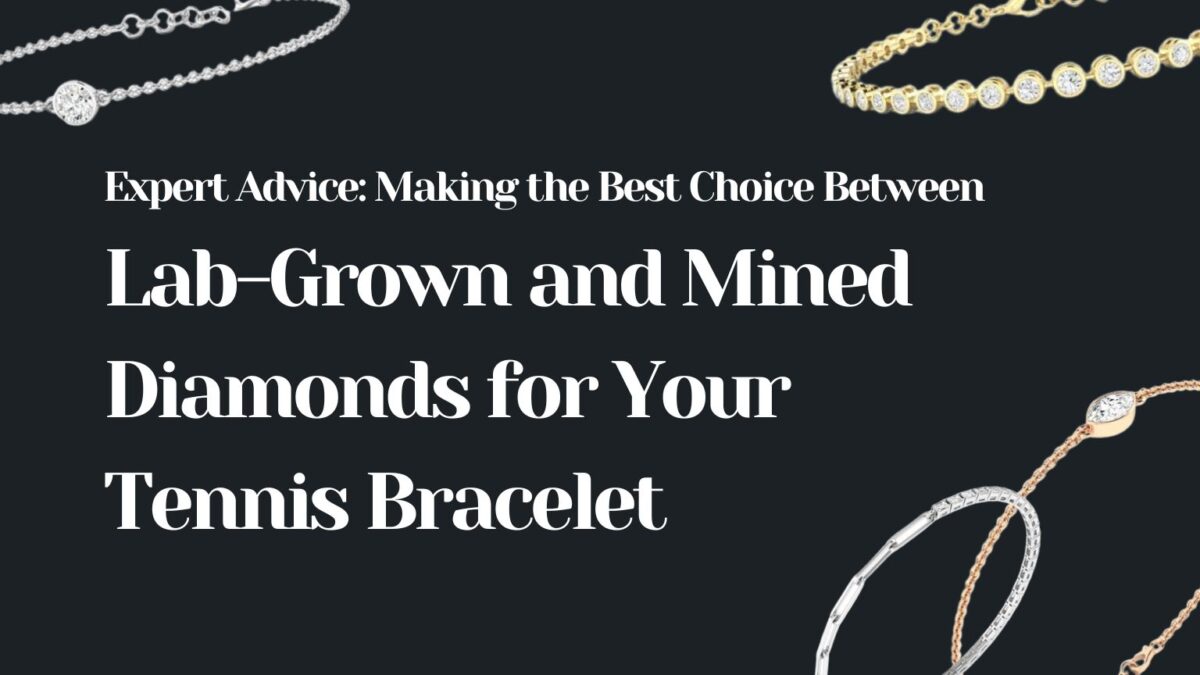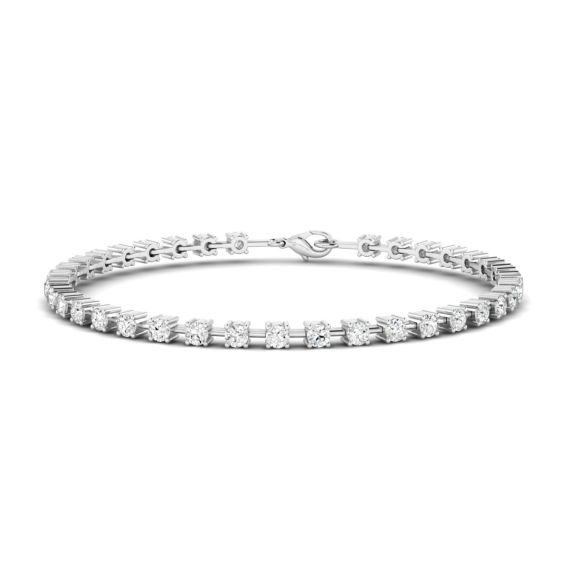Should I Choose Lab Grown or Mined Diamonds for My Tennis Bracelet?
When selecting diamonds for a tennis bracelet, one of the first decisions you’ll need to make is whether to go with lab-grown or mined diamonds. Both have their advantages and disadvantages in terms of cost, appearance, environmental impact and more.
Lab-grown diamonds are becoming an increasingly popular option. They have the same physical and chemical properties as natural diamonds, and to the naked eye are virtually indistinguishable from mined diamonds. The main difference lies in how they are produced – lab diamonds are cultivated in highly controlled laboratory environments, whereas mined diamonds originate deep within the earth.
In this article, we’ll break down the key differences between lab and mined diamonds to help you determine which is the better fit for your new tennis bracelet. We’ll compare factors like cost, visual appearance, eco-friendliness and more. We’ll also provide advice on how to care for and clean lab diamond jewelry. Let’s explore your options!
What are the Main Differences Between Lab and Mined Diamonds?
While lab diamonds essentially replicate the properties of natural diamonds, there are some key differences:
- Lab diamonds are manufactured in a highly controlled laboratory environment using cutting edge technology, whereas mined diamonds originate from deep within the earth and vary more in quality.
- The production process for lab diamonds generates virtually no waste and has less environmental impact than traditional diamond mining.
- Well-cut lab diamonds have exceptional brilliance and sparkle that rivals high quality mined diamonds, available at a fraction of the price.
- Lab diamonds typically have very few imperfections or inclusions since they are cultivated in controlled conditions, whereas inclusions are common in mined diamonds.
- Lab diamonds are graded on the same 4Cs scale as natural diamonds – carat, cut, color and clarity. However, the grading criteria differ slightly between the two.
At face value, a high-quality lab diamond gemstone looks identical to a comparable mined diamond, even under a jeweler’s loupe. The choice comes down to personal preferences around factors like ethics, environmental impact, and budget.
Are Lab Diamonds Less Valuable Than Mined Diamonds?
In terms of monetary value, lab diamonds tend to retail for about 30-40% less than comparable natural diamonds. This is because factors like scarcity and perceived prestige allow mined diamonds to command higher prices in the market.
However, lab diamonds have the same hardness, brilliance and fire as a mined diamond – essentially indistinguishable to the naked eye. Well-cut stones with excellent color and clarity grades face up beautifully regardless of their origin.
So while mined diamonds may retain higher financial value on paper, the difference is negligible when it comes to appearance. An exquisitely crafted lab diamond tennis bracelet will look virtually identical to a bracelet with natural diamonds. For all intents and purposes, lab diamonds can make just as stunning and valuable jewelry!
How Do Lab Created Diamonds Compare to Mined Diamonds in Terms of Cost?
Lab Diamonds Are Much More Affordable Than Mined Diamonds
One of the most compelling reasons to choose lab diamonds is their significant price advantage compared to rare and finite mined diamonds. Even high-quality, well-cut lab stones with impressive color and clarity grades retail for about 30-40% less than comparable natural diamonds.
Do Lab Grown Diamonds Have the Same Properties as Mined Diamonds?
Lab Diamonds Have Identical Optical and Physical Properties
Lab diamonds are compositionally and atomically identical to mined diamonds – the only difference lies in their origin. Their chemical structure, hardness, brilliance, and fire are literally an exact replica of earth-mined diamonds.
In terms of optics, you simply cannot tell the difference between a well-cut 1-carat lab diamond and a 1-carat natural diamond without sophisticated testing equipment. Both exhibit the same exceptional sparkle, fire, and brilliance.
When it comes to physical properties, lab diamonds rate a perfect 10 on the Mohs scale of hardness, just like natural diamonds. This makes them incredibly durable and ideal for jewelry exposed to daily wear and tear.
So if you’re seeking the dazzling radiance and enduring durability of a mined diamond, rest assured that an exquisite lab diamond will offer the exact same optical and physical traits.
Lab Diamonds Are Chemically the Same as Mined Diamonds
Lab diamonds have the identical chemical composition and crystal structure as natural diamonds – pure carbon arranged in a cubic crystal lattice. They are not stimulants like moissanite or cubic zirconia.
The only difference with lab diamonds lies in how they are formed. Mined diamonds crystallize over billions of years under intense heat and pressure deep below the Earth’s crust. Lab diamonds use technology to simulate these conditions above ground in a highly controlled laboratory environment.
But the resulting gems are chemically identical in every way. They have the same molecular structure responsible for the sheer brilliance, fire and durability of diamonds. So when it
comes to material properties, there is no chemical difference between lab-created and mined diamond gems.
What are the Ethical Considerations Around Lab Grown vs Mined Diamonds?
Lab Diamonds Are More Ethical and Eco-Friendly
One of the most compelling arguments in favor of lab diamonds is their positive ethical and environmental profile compared to the issues surrounding some diamond mining practices.
Lab diamonds are manufactured sustainably in high-tech laboratories, reducing environmental impact. The process emits negligible carbon and requires no large-scale mining or disruption of land. There are also no concerns around unethical working conditions often associated with artisanal mining in some parts of the world.
So consumers who value ethical sourcing and eco-friendly production often prefer lab diamonds over mined. Lab diamond jewelry lets you sparkle gorgeously with a clear conscience!
Mined Diamonds Carry Some Ethical Concerns
While the diamond industry has made strides in ethical mining practices and certification schemes, some concerns do persist around mined diamonds:
- Environmental impact from mining activities like deforestation, destruction of ecosystems and pollution.
- Dangerous working conditions and lack of workers rights protections in some mining regions.
- Limited traceability for stones mined in conflict zones associated with violence or human rights issues.
However, consumers do have options like choosing certified, conflict-free natural diamonds from mines with demonstrated ethical practices. Ultimately, the choice comes down to aligning your personal values with the origin of your diamonds.
Will a Tennis Bracelet With Lab Diamonds Look the Same?
Well-Cut Lab Diamonds Sparkle Just Like Mined Diamonds
An exquisitely crafted tennis bracelet with lab diamonds will look virtually identical to a bracelet with mined diamonds. The key is choosing high quality, well-cut lab stones.
When expertly cut and polished, lab diamonds exhibit the same light performance as top-tier mined diamonds. They showcase exceptional brilliance, fire and scintillation that rivals any natural diamond.
With precise cutting and symmetry, light dances through a lab diamond tennis bracelet just as beautifully as an earth-mined bracelet. Only a trained professional could attempt to tell the difference with special equipment.
Bottom line – a well-crafted lab diamond bracelet with optimal cut grades will sparkle, dazzle and impress just like the real thing!
Only an Expert Can Tell the Difference Between Lab and Mined
While lab diamonds essentially replicate the appearance of mined diamonds, specialized equipment can potentially detect minute differences between them:
- With an electronic diamond tester, lab diamonds conduct heat and electricity differently than natural diamonds due to subtle differences in impurity levels.
- Advanced spectroscopic devices can reveal the presence of nitrogen impurities acquired during the mining process for natural diamonds.
However, this requires high-tech tools and expertise well beyond what the average consumer has access to. Without such detection methods, there is truly no way to differentiate a high quality lab diamond from a mined one simply by sight.
So unless you plan to have your tennis bracelet scientifically scrutinized, you can rest easy knowing your beautiful lab diamonds will easily pass as the real deal!
What Settings Should I Choose for My Lab Diamond Tennis Bracelet?
Prong Settings Showcase Lab Diamonds Well
When selecting a setting for a lab diamond tennis bracelet, prong settings are an excellent choice to maximize sparkle.
Prong settings secure diamonds in place using four or six thin metal claws, allowing more diamond surface area to reflect and refract light. This showcases a lab diamond’s impressive brilliance, fire and scintillation.
Additionally, prong settings
Additionally, prong settings allow light to pass through the diamonds for exceptional radiance compared to other setting types. Whether choosing white gold, yellow gold or platinum prongs, this setting gives lab diamond tennis bracelets gorgeous visual appeal.
One consideration with prong settings is that the metal claws can develop small gaps over time, potentially allowing diamonds to become loose. However, high-quality construction and periodic inspections can address this issue.
Overall, prongs are a wonderful choice to make the most of your gorgeous lab diamonds in a gracefully designed tennis bracelet.
Bezel Settings Offer Protection for Active Lifestyles
For tennis bracelets meant for everyday wear, bezel settings provide an attractive and protective option.
Bezel settings surround lab diamonds in a slim metal rim custom-shaped for each stone. This not only secures diamonds firmly in place, but also acts as a buffer between the gem’s surface and potential knocks or scratches during daily wear.
While bezels cover some diamond surface area compared to prongs, they allow cleaned diamonds to still shine beautifully. Solid gold or platinum bezels also lend tennis bracelets a sleek, contemporary look.
For sporty, active lifestyles, bezels are ideal to safeguard a lab diamond bracelet from damage while retaining stylish appeal. With proper care, bezels can let you sparkle with confidence!
How Should I Care for and Clean a Lab Diamond Tennis Bracelet?
Use Soap and Water to Clean Lab Diamond Jewelry
Caring for lab diamond jewelry is pleasantly low-maintenance compared to other gemstones. As the hardest material on Earth, diamonds are less prone to damage from daily wear and tear.
Gentle cleaning is recommended about once per month or when dirt buildup is visible. Use mild dish soap and lukewarm water, along with a soft-bristled cleaning brush to dislodge grime from bracelet crevices and behind diamonds.
After scrubbing gently, rinse thoroughly with clean water and pat dry with a soft lint-free cloth. This will restore shine and allow your bracelet to sparkle like new! Be sure to remove tennis bracelets before cleaning or exposure to chemicals like chlorine.
With occasional care, a high-quality lab diamond tennis bracelet will retain its dazzling radiance for many years of enjoyment.



